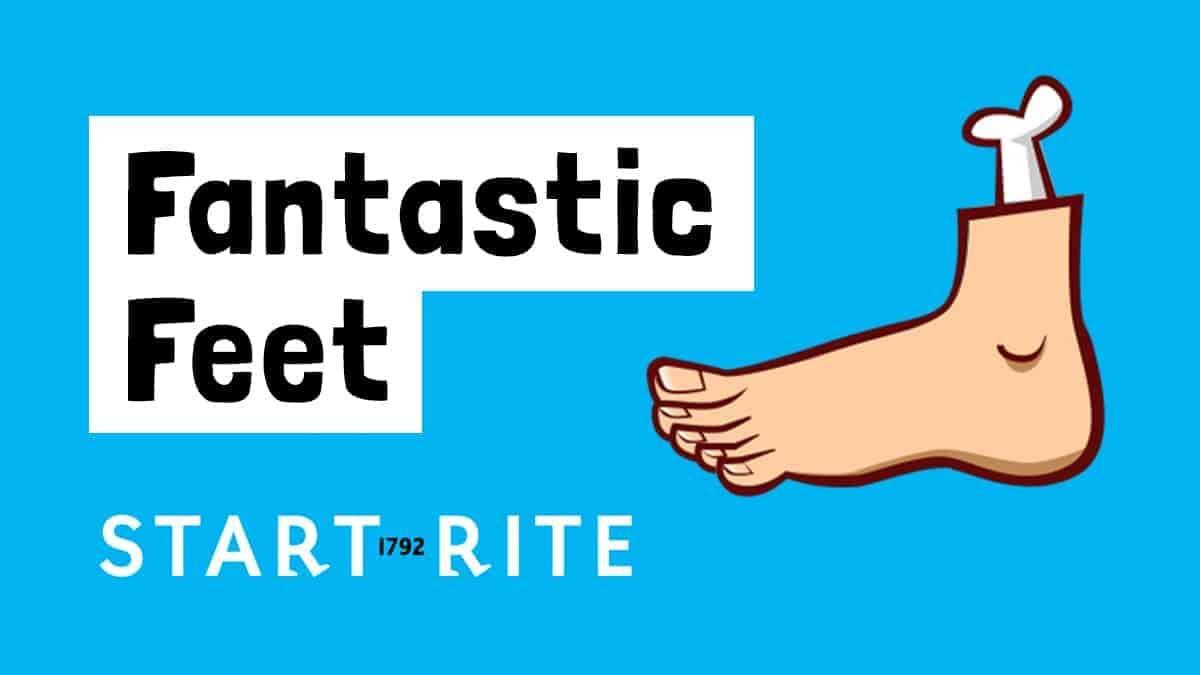Feet are one of the most hard-working parts of our amazing bodies. They help us walk, skip, run, ride bikes, jump and dance in a thousand different ways. But most of the time we don’t spare a thought for our fabulous feet.

Here are the bare bones…
Your feet have to carry a lot of weight and that wouldn’t be possible without bones. There are a lot of them in each foot, each one working hard to keep you on your toes! Each foot has 26 bones – from the small phalanges (say fal-an-jeez) in your toes to the longer metatarsals (say met-a-tar-sals) as well as the two bones which make up your heel – the heel bone and the talus.
As well as all these bones, there are 33 joints and over 100 muscles and tissues which help the foot to move flexibly. No other part of the body has as many bones, in fact your feet account for 25% of the total bones in the body!

Young feet are hard workers!
You know it can be hard being a kid – and when it comes to feet, your feet definitely work harder than you think! Because your feet move a lot, they sweat a lots too – between 2 and 3 times more than an adults’ feet! That’s why your shoes wear out more quickly than your parents’ – both on the inside and the outside. Sweat can damage the inside of shoes, so it’s always a good idea to wear cotton socks to help your feet breathe.
Keeping your feet fit!
With such an important role in the body, it’s easy to see why it’s important to look after them. Here’s some top toe tips:
- Wash your feet every day with soap and water, and make sure you dry them carefully too – damp crevices help bacteria to grow which can lead to some nasty whiffs!
- Make sure you wear shoes and socks that fit correctly, and where possible choose natural materials. Leather can stretch and cotton can help your feet breathe.
- Your feet grow fastest when you’re a kid – and don’t slow down growing until you’re in your late teens. It’s therefore important to be measured frequently – and that means both length and width.
- Cut your toenails regularly – and always in a straight line! That will help prevent nails digging in.
- When you’re not wearing your shoes make sure they have a chance to breathe and to dry, especially if they are damp or you’ve been outside in the rain.
What’s wrong with my feet?
Every now and again, something might go wrong with your feet.
Lumps and bumps
Calluses and corns are hard patches of skin that form when the skin on your feet press uncomfortably against the inside of your shoes. Whilst it’s normally adults that get them, it’s a good idea to make sure your shoes are a great fit so there’s no rubbing points.
Barefoot Bliss
Going barefoot in grassy or sandy places or even around home can feel great – it helps give your feet a chance to stretch out and get some fresh air. But always be careful to watch out for things which might damage your feet, especially when outside. Broken glass, metal and other sharp objects may be left around in public places and might not be easy to spot.
Verrucas
Many children get verrucas – they’re a kind of wart. They tend to appear on the sole of your feet and look like a small dot or dots. Sometimes they will increase in size and number, and cause pain when you walk. Although many go away by themselves in around 6 to 9 months, there are lots of ways to treat these pesky problems – ask your pharmacist or GP for help!
Not for sharing!
It’s great to share but there are some things we do NOT want to share with other people and verrucas are one of these things. They can be contagious – that means people can get them by sharing flannels and towels, or from the swimming pool floors where you’ve walked. So it’s important to wear a special plastic sock when you are swimming and don’t share your towels with other.
Athlete’s Foot
This uncomfortable problem is caused by a fungi which loves to sit in the damp dark sweaty bits between your toes. It can be itchy and sore but there are lots of treatments you can get, both from a pharmacist and from your doctor to get it moving! A great way to avoid this troublesome toe-dweller is to make sure your feet stay clean and dry.
And finally, some fascinating fun feet facts
- Penguins use their feet to protect their eggs
- Millipedes and centipedes certainly have a lot of feet but not as many as their name suggests. Depending on the species they may have as few as fifty or some as many as 200!
- Each foot has a quarter of a million sweat glands.
- Feet have over 8,000 nerve endings – that’s what makes them terrifically ticklish!
- Humans have worn shoes for many millennia. Some of the oldest shoes ever found date from over five thousand years ago!
- The average person will walk 100,000 miles in their life – thanks to our fantastic feet!







